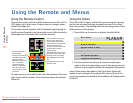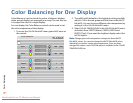
Connecting Source
Cables
3
Connecting Source Cables
The three types of picture sources are:
• Analog computer (from UXGA
down to VGA)
• Digital computer
• Video (optional with VIM)
• Composite (NTSC, PAL or
SECAM)
• S-Video (50Hz or 60 Hz)
• Component (480i, 480p, 576i, 576p, 720p, 1080i)
• SDI (Serial digital interface inputs from 480i to 1080p)
Digital Video Interface (DVI) is a standard for digitally connect-
ing computers to their monitors or for interconnecting displays.
The m40L/m46L converts the analog inputs to the DVI standard
and makes this available at the Digital Out connector. This
means you can bring in a picture source - UXGA, SXGA, VGA,
1080p - to the first display and connect the rest of the displays in
the loop with DVI. The advantages of DVI are:
• DVI is less subject to picture degradation than analog methods
of loop-through. (Even with DVI, loop-through is not infinite.)
• DVI inputs require much less setup and adjustment. You adjust
the picture in the first display only, the display with the analog
input. Setup time is reduced.
Depending on which input is selected, the Digital Out connec-
tor will show the picture from the analog input or the digital
input.
Selecting the Correct Input
The following table gives you common examples of which
devices have which inputs. In terms of input quality, the table is
ordered from the most desirable input to the least desirable
input.
Analog
Input
Digital
Input
Video Inputs
Input Found on the Following Devices
DVI Computers with digital out capability
SDI
(optional)
Studio quality video equipment
Analog Computers, laptops
RGB and RGBS from video processors or other profes-
sional equipment (may need BNC to DB15 adapter
cable). These may have separate sync, composite or
sync on green.
Component DVD players
Set top boxes (e.g. for cable TV or satellite TV)
Any YPbPr signal
S-Video DVD players
Set top boxes
VCRs
Composite TV tuners
VCRs
Set top boxes
Downloaded From TV-Manual.com Manuals
















